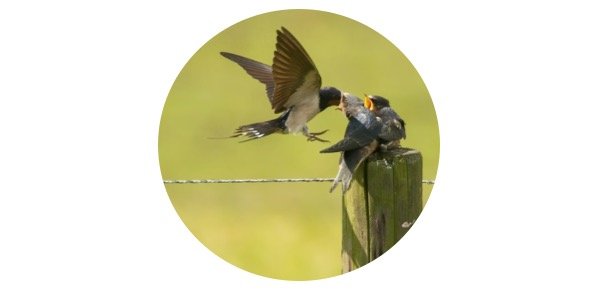Baby Pigeons: All The Facts, Care, And Pictures
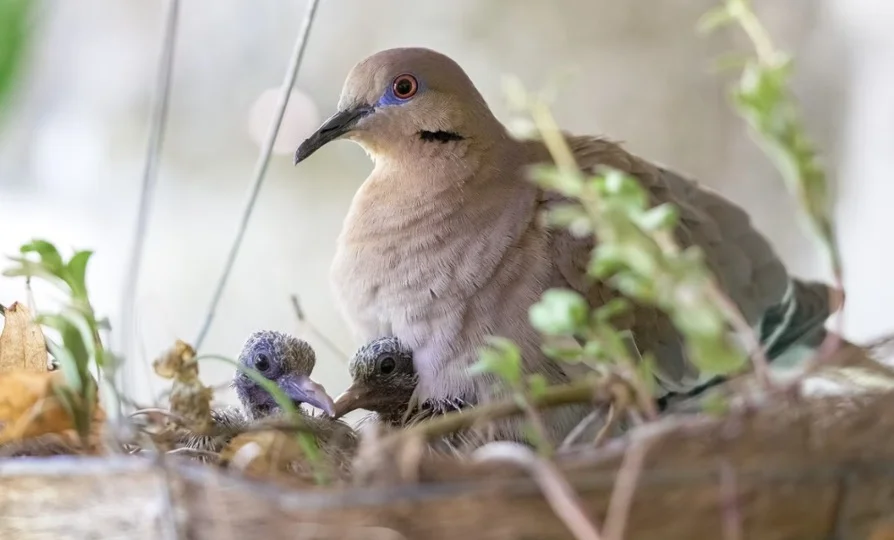
Pigeons are almost everywhere as well as anywhere we go. There is usually an abundance of feral pigeons (rock doves) and wood pigeons in towns as well as in cities. But little is known about their babies (baby pigeons), so we’ve developed this post to try to address as many frequent questions regarding baby pigeons as possible, along with some baby pigeon pictures.
What Does A Baby Pigeon Look Like?
Newly hatched pigeons have pink or black skin and a patchy layer of yellow that will ultimately turn into feathers – this can occasionally be white. The beak, wings, as well as feet are significantly larger in comparison to the body; nevertheless, they develop into these traits as they grow larger.
The beak is generally pinkish, but it can occasionally be darker. Slate grey is the color of the foot. Hatchlings are altricial, which means they are born underdeveloped and rely on their parents for care as well as food. Babies are born with their eyes closed. They also lie prone, elevate their heads, as well as open their bills on a weekly basis.
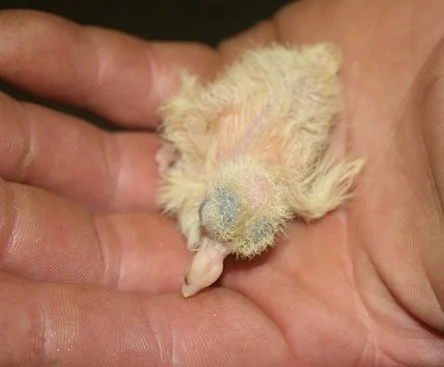
When a young pigeon is between 4 to 5 days old, its eyes open. In general, unless you domestically raise pigeons or manage to stumble into a pigeon nest, you’ll never see the baby pigeons in this condition; however, this is rare because pigeons like to nest in high and remote areas. We usually encounter baby pigeons when they reach their juvenile stage, which is generally comparable to the adult stage.
What Is A Baby Pigeon Called?
Squabs are young pigeons. A squab is a young, immature pigeon that is too young to fly, generally less than four weeks old.
What Are The Development Stages Of Baby Pigeons?
- Stage 1 (Hatchlings): Covered in golden fluff with a small stubble where the feathers are beginning to develop.
- Stage 2 (Nestlings): Partially or almost fully feathered, with a short tail. They may still have some golden fuzz around their head as well as neck.
- Stage 3 (Fledglings): Look remarkably identical to adults, but lack iridescent feathers on the neck.
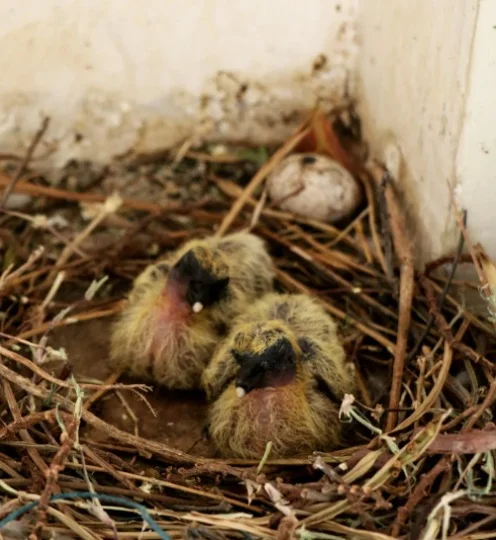
Who Cares Baby Pigeons, Mother or Father?
Many species in the animal realm are nurtured solely by their mothers, but the newborn pigeon is not one of them. Unlike many other animals, both male and female pigeons incubating their young alternate as they await hatching.
Interestingly, both male and female pigeons generate “crop milk,” a nutrient-rich secretion for their young. Overall, both male and female pigeons nurture their young, which distinguishes them from other birds on the world. A pair of pigeons commits to more than just raising their young. When two mature pigeons’ mate, it is for life.
Throughout their lives, the pigeons collaborate to defend their offspring from predators by producing soothing coos when danger is around. If there is a hazard nearby, the parents will also divert the predator from their children.
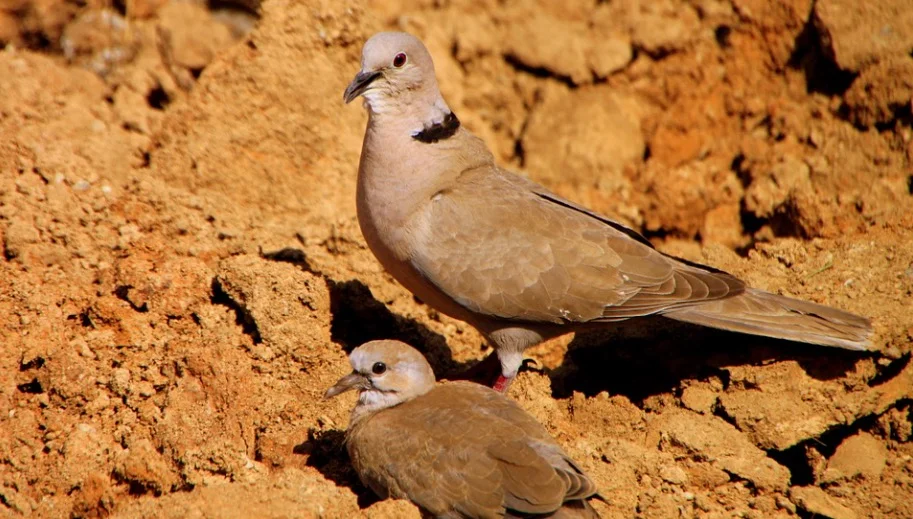
What Is Crop Milk?
Crop milk, often known as pigeon milk, is a secretion from the crop lining (a ‘compartment’ where pigeons can store food prior to digestion). It is a semi-solid, crumbly excretion high in fat and protein that some bird species feed to baby birds during the first days after hatching.
Unlike mammalian milk, crop milk or bird milk does not have any calcium or carbohydrates. The exact composition of crop milk varies depending on the bird species and the parent bird’s diet.
Crop milk ranges in color from whitish to yellow, gray, or beige, and contains a variety of substances, including:
- Fat
- Protein
- Minerals
- Antioxidants
- Antibodies
- Anti-bacterial
Crop milk is only fed to young birds for a few days until they are able to digest other foods, and parent birds may gradually mix adult food in with the young birds’ diet to wean them off crop milk.
Why Don't We See Baby Pigeons?
Some may believe that squabs aren’t real because they’re rarely observed in the wild. Believe it or not, there is a reasonable explanation for why this story is so widely spread. Because baby pigeons cannot fly, they spend their whole life in the nest with their parents.
Some pigeons will make it to the ground but will be unable to return to their nest in the trees. When this happens, the young birds will beg for food and resources from their families as well as other adult pigeons until they can return to their safe havens.
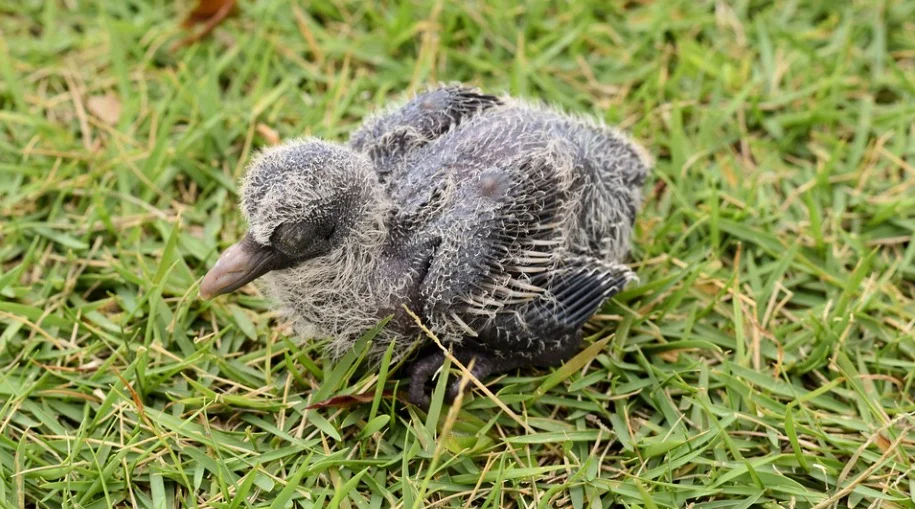
How Big Are Baby Pigeons?
When newly hatched, pigeon youngsters are generally about 5cm long.
How Much Does A Baby Pigeon Weigh?
For newly hatched chicks, the average weight is roughly 15g. Baby pigeons gain between 4 as well as 8 grams per day, reaching a weight of 270 – 350 grams at 30 days of age.
What Do Baby Pigeons Eat?
Both male as well as female birds provide regurgitated crop milk to baby pigeons. For the first four days, this is regurgitated to the fledgling birds within two hours after hatching. Following that, they will be given crop milk and seeds for another 5 days. Around day 9, the newborn pigeons will be fed an adult diet.
This includes seeds, fruits, as well as invertebrates on occasion. The amount of food supplied to young birds grows on a regular basis, especially when seeds are added. For the first week, both parents must feed two newborns. Following this, one adult can usually effectively feed two squabs.
How Do Pigeons Feed Their Babies?
Adults return to the nest between 3 as well as 4 times a day to feed the chicks crop milk, seeds, or whatever component of the diet they are on. Squabs eat the same quantity of food every day. Young pigeons make a peeping sound and may raise their heads to be fed by adults.
After four days, newborn pigeons will push against their parents to acquire food as well as be fed. Young birds will continually beg and cry for food from approximately 7 days, when they will typically eat twice a day.
How Long Are Baby Pigeons In The Nest?
The amount of time spent in the nest varies depending on the season. In the summer, it is normally between 25 as well as 32 days, while in the winter, it can be up to 45 days. It’s normal for a newly fledged pigeon to lose a lot of weight in the first several weeks.
This is due to the fact that they are typically hefty before leaving the nest. Most young pigeons fledge a day or two before they are completely capable of flying and spend a few days grazing on the ground.
Pigeons may fledge and become unable to return to their nest in rare instances. This can occur when the nest is high up and the baby bird is unable to fly. If this occurs, the baby pigeons will frequently beg their parents and other adults for food.
What Does A Juvenile Pigeon Look Like?
Because juvenile and fledgling pigeons resemble adult plumage, many people are perplexed as to what newborn pigeons look like. This is due to the fact that they spend a lot of time in the nest and are practically fully grown when they fledge.
It also varies depending on the type of pigeon, but in general, the cere on youngsters as well as on fledglings – the white growth that lies above their beaks – will be pinkish-grey rather than white.
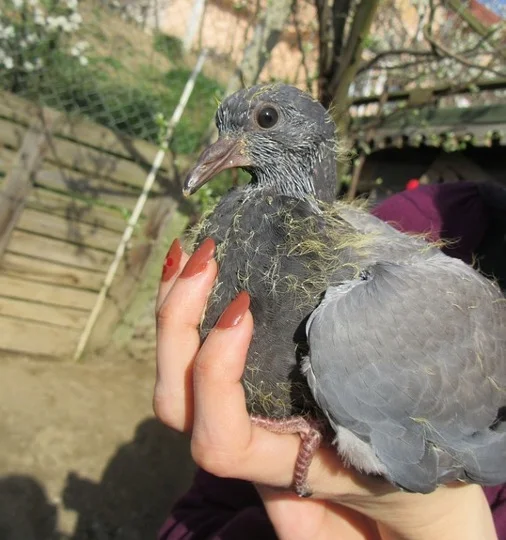
They also lack the gleaming purple and green trim around the neck. Adult pigeons have yellow, orange, or reddish-orange eyes, whilst juveniles have medium-brown or greyish-brown eyes. The feathers surrounding the eyes may also be darker than in adults.
Fledging pigeons are more common than you think, so the next time you encounter a flock of pigeons, use the suggestions above to spot the baby pigeons.
When Can Baby Pigeons Fly?
In general, newborn pigeons can fly at roughly 6 weeks of age. However, around 4 weeks, they will begin to flap their wings in order to practice and learn. During this time, you may frequently witness them taking off as well as landing with minor elevations from the ground.
It’s completely instinctual, as it is with all flying birds, and will occur immediately after the bird has fledged the nest. Parent pigeons are incredibly supportive of their kids as they learn to fly and will nudge them to urge them to move about.
What Happens When The Young Pigeons Leave Their Nests?
When newborn pigeons leave their nests for the first time, they are completely unaware of their surroundings. They are in such a fragile state right now, unable to fly or even feed themselves on their own.
For a few days, the mother or father pigeon will accompany them, after which the pigeons will be able to master their sustenance abilities. It takes a few attempts for the pigeons to learn to use their flight feathers and fly proficiently.
Even when the pigeons had fully matured and developed into distinct species, they would return to the original nesting sites from time to time. They would spend much of their time in the center regions with their other mates, only sometimes returning to their nests.
When these pigeons achieve sexual maturity at 7 months, they quit their natal nests and travel on to find a spouse, build their nests, and produce young throughout the mating season.
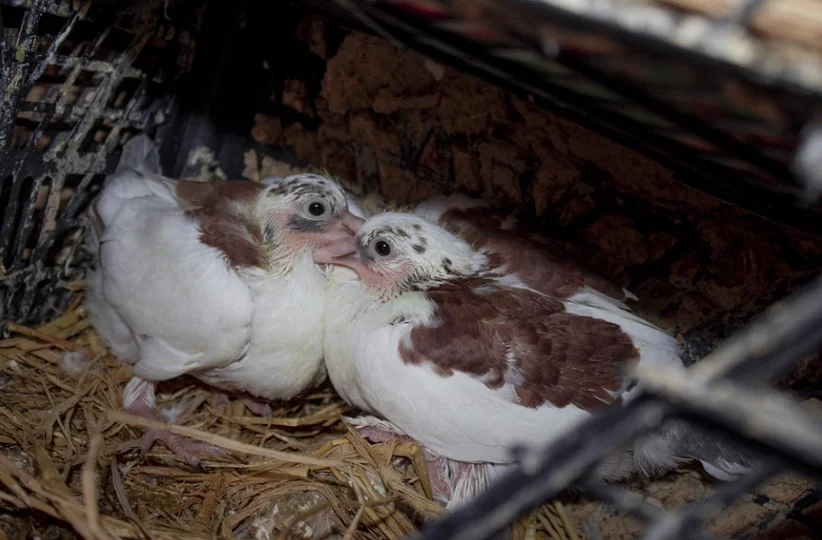
Do Baby Pigeons Are Born with A Built GPS?
There was a period when carrier pigeons made up around one-fourth of all birds in the United States. Carrier pigeons transport messages from one person to another. These pigeons were chosen because they can find their way home from long distances. This means that these small birds are born with their own unique GPS system!
With the introduction of cellphones as well as the internet, the employment of carrier pigeons for travel became outdated, but their influence on communication had a significant impact on the world as we know it today.
Do Pigeon Babies Are Incredibly Intelligent?
Many things demonstrate the newborn pigeon’s intelligence. One of the most important is that they can pass the “mirror test.” The mirror test is a self-awareness test that involves placing the animal in question in front of a mirror.
The test is passed if the animal is aware that the picture in front of them is their reflection. Animals that believe they are seeing another animal, on the other hand, fail the test.
Only nine creatures pass this test, including pigeon chicks. Pigeons initially shown their ability to pass this exam in 1979.
Do Squeakers Have Extraordinary Hearing and Sight?
Squeakers are born with their eyes closed. These juvenile pigeons, however, can see almost 25 miles distant just a few weeks after hatching. Baby pigeons are also unusual in that they can detect volcanic activity as well as impending storms.
Scientists believe that they can detect infrared sound produced by storms, volcanoes, as well as tornadoes. These noises are inaudible to humans because their frequency is too low for our ears to detect.
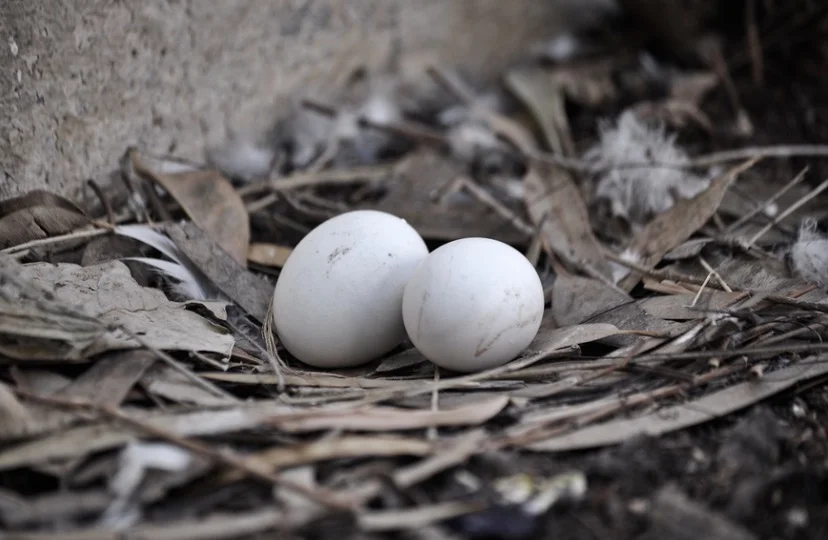
What Do Pigeon Eggs Look Like?
Pigeon eggs are tiny as well as white, measuring 38.4mm in length as well as 28.6mm in breadth. The weight is 14.6g on average. The thickness of eggshell is around 0.18mm.
How Long Do Pigeon Eggs Take To Hatch?
Eggs typically hatch between 16 as well as 19 days after being deposited. Hatching can occur at any time of day as well as takes around 24 hours to complete. The majority of the time, both eggs hatch at the same moment.
The empty eggshells will be removed from the nest by the parents. Both sexes share incubation duties, with the male incubating from mid-morning to late afternoon as well as the female incubating from late afternoon to mid-morning.
When Are Pigeons Born?
Pigeons normally reproduce all year, so eggs can hatch at any time. The majority of young pigeons hatch in the spring as well as summer, between May as well as June as well as August as well as November, respectively.
Where Do Pigeons Nest?
Nests are typically built on ledges beneath shelter. This may happen in a variety of places, including caves, coastal cliffs, nooks as well as crannies, gutters, homes, barns, sheds, and even holes in trees.
The most important requirement is a level surface in a covered area. Males normally choose the location for the nest, and once discovered, females will wait on it while the male gathers materials to build the nest.
The materials utilized are typically a combination of wood, twigs, roots, straw, leaves, feathers, as well as a variety of other things. Once retrieved, the male returns the material piece by piece to the female, who takes it in her beak as well as tucks it around her breast or flanks to eventually create the nest.
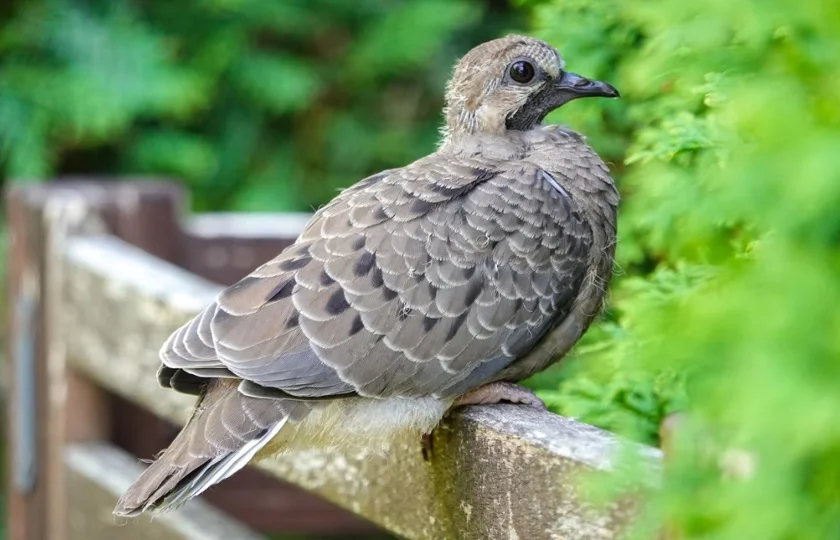
Do Pigeons Reuse Their Nests?
Pigeons frequently reuse existing nesting sites and will build new nests on top of the old ones. This is usually due to the buildup of feces on the previous nest. As a result, nests that are 4 years old can reach up to 20cm tall as well as 50cm broad.
They may also weigh more than 2kg as well as have 8cm deep bowls. How long do pigeon babies stay with their parents? They will normally remain 1 to 2 weeks in the area of their parents house once they have fledged.
Why Don't You See Baby Pigeons?
Baby pigeons are uncommon because they spend far more time in the nest than other birds (on average 30 days). When they fledge, their plumage resembles that of adult birds. They can be difficult to detect, but it is not impossible.
Another explanation is that pigeons prefer to nest in situations where they are entirely hidden. Church towers, beneath bridges, chimneys, as well as abandoned structures in towns and cities are typical examples. In general, we will never see a pigeon’s real nest as well as, as a result, we will never see pigeon offspring.
This natural inclination to nest high up stems from their descent from rock doves. Rock doves, as the name implies, nest on cliff edges as well as put their nests back into the face to protect them from predators.
How To Identify The Young Pigeons In A Flock?
Pigeons are so numerous that you may have seen a swarm of young ones as well, but because they are so similar to their adults, they are difficult to distinguish. You might be staring at one yet be unaware of it. Look closely to find these distinctions!
The feathers would not have completely molted yet. The iridescent greens as well as purples surrounding the adult’s neck are gone in the freshly grown youngsters. Examine the black eyes of the youngsters in comparison to the crimson, orange eyes of the adults.
In the almost completed plumage, notice the tapering feathers of the young’s wings, as well as a few little ones peeking out of its head. The thick pinkish-grey wattle on top of the bill must be changed into a white wattle like in adults.
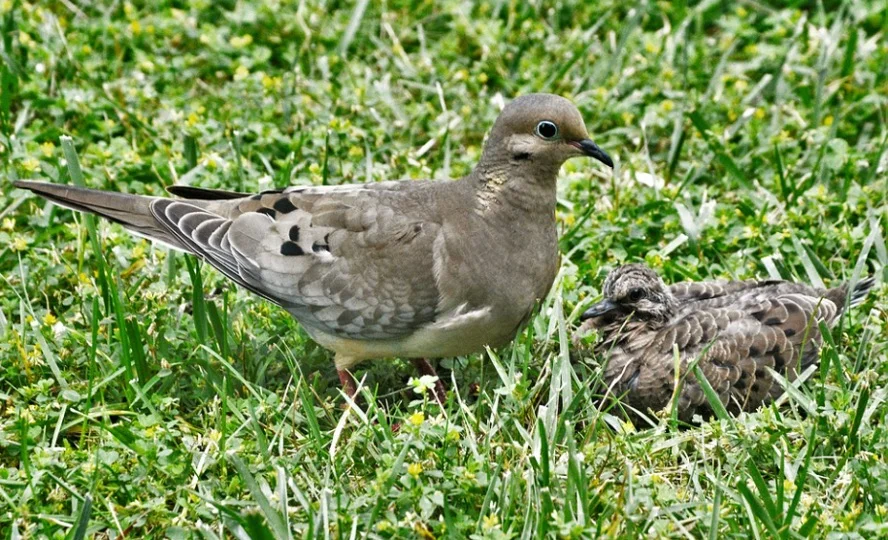
What To Do If You Find A Baby Pigeon?
Most of the time, the best thing to do is to keep an eye on the fledging as well as keep pets away. Most of the time, the parents are close and observing. Because the sight of a human might scare the parents away, you may not be able to view them all of the time – which is why it’s critical to observe from a distance.
If the pigeon looks to be wounded or is not at the fledgling stage, get guidance from your local bird or wildlife rescue. This is due to their ability to identify whether the bird need rescue. If the pigeon is in immediate danger, move it to a safe and secure location nearby.
Do Pigeons Mate For Life?
Yes! Pigeons do, in fact, mate for life. They are monogamous and usually mate with the same spouse for the rest of their lives. If the worst happens and their companion dies, they will almost always find a new relationship. This, however, takes time as well as is not as rapid as other birds.
Can Baby Pigeons Survive Without Their Mother?
Yes, newborn pigeons may live solely on the attention of their fathers. This is due to the fact that both parents are active in rearing the kids, implying that the male bird is equally capable of parenting the young. This is, of course, a far more difficult task for the adult, but it is doable.
Where Are All The Baby Pigeons?
Many scientists have asked, “How frequently do you encounter the babies of other bird species?” The only baby birds that are commonly seen in most towns are those of ducks, geese, and other waterfowl. Baby birds of different species are unusually rare. So, why is this the case?
Pigeons hatch from their eggs in a nest, which is usually high up in a tree or in another secluded area. When a mother pigeon constructs her nest, she does so in a location that will be secure as well as warm for her young.
Unless you go looking for the nest, you’re unlikely to spot a young pigeon until it grows up and is ready to leave the nest. Before they fly out of the nest, pigeons are fully developed and resemble adult pigeons.
Pigeons spend longer time as nestlings than other birds, thus the chances of encountering one that is still a baby are slim. The fact that you can’t see the infants doesn’t mean they aren’t there. You might be able to discover a nest if you listen carefully or monitor where the mother pigeons travel.
Approaching the nest or attempting to touch the young pigeons might frighten the mother and prevent her from returning to care for her offspring. Another reason experts believe we don’t see young pigeons much is because they don’t build their nests in typical places.
As previously said, you may spot the occasional pigeon in a tree, but pigeons prefer to make their nests in inconvenient areas. This includes roofs, bridges, and the sides of towering structures. Pigeons may make their nests in caves, under rocky cliffs, or other flat, well-covered spots in less populated areas.
These locations keep the newborns protected from the elements as well as predators. Even if a youngster did jump out of the nest in these situations, it’s so hidden away that you wouldn’t see it anyhow.
FAQs About Baby Pigeons
How much do baby pigeons weigh?
Pigeons come in over 300 different species, as well as no two are similar. A newly born pigeon weighs around 15 grams on average, however this might vary substantially. A young pigeon will weigh at least 18 times its birth weight when it is a month old.
What do baby pigeons eat?
For the first week as well as a half of their lives, baby pigeons eat a relatively basic diet. The squeakers rely only on their mothers as well as fathers to regurgitate crop milk for them until approximately day 5, when they will begin experimenting with seeds in addition to their milk diet. Around a week as well as a half in, they begin to get food from their parents that they will generally consume as adults, such as seeds, insects, as well as fruits.
Where do baby pigeons live?
Baby pigeons are unable to fly properly, if at all. As a result, after hatching, they are confined to their family nest for 25-35 days in the summer as well as up to 45 days in the winter.
These nests may be found practically anyplace there is a surface for the nest to perch on as well as it is in a dry location. Some pigeons may even reuse existing nests by constructing a new one on top of the old one, resulting in nests that are several feet wide!
What are baby pigeons called?
Baby pigeons are known as squabs, or squeakers in some cases. Until they reach the age of a month, these newborns are officially only squabs. A flock is a bunch of pigeons.
